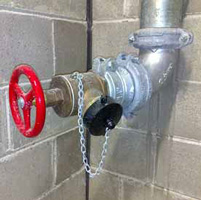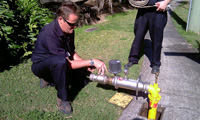Fire Hydrants
Fire hydrants are active fire protection measure as a source of water in most rural, suburban and urban areas with a municipal water service allowing access by fire fighters.
A hose is attached to the fire hydrant, and then the valve is opened to provide a powerful flow of water. The hose can be further attached to a fire engine which can then use a powerful pump to boost the water pressure and split it into multiple streams. The hose may be connected with a threaded connection. The water inside a charged hose line causes it to be very heavy and high water pressure causes it to be stiff and unable to make a tight turn while pressurized. When a fire hydrant is unobstructed, this is not a problem, as there is enough room to adequately position the hose.
Most fire hydrant valves are not designed to throttle the water flow; they are designed to be operated full-on or full-off. The valve arrangement of most dry-barrel hydrants is for the drain valve to be open at anything other than full operation. Usage at partial-opening can consequently result in considerable flow directly into the soil surrounding the hydrant, which, over time, can cause severe scouring. A hose with a closed nozzle valve, or fire truck connection, or closed gate valve is always attached to the hydrant before opening the hydrant’s main valve.
 When operating a fire hydrant, appropriate personal protective equipment such as a helmet with face shield, are typically worn. High-pressure water coursing through a potentially aging and corroding hydrant could cause a failure, injuring the firefighter operating the hydrant or bystanders.
When operating a fire hydrant, appropriate personal protective equipment such as a helmet with face shield, are typically worn. High-pressure water coursing through a potentially aging and corroding hydrant could cause a failure, injuring the firefighter operating the hydrant or bystanders.
Fire Hydrants are subject to bi-annual and annual inspections, annual flow testing and five (5) yearly testing in accordance with AS1851-2012.




